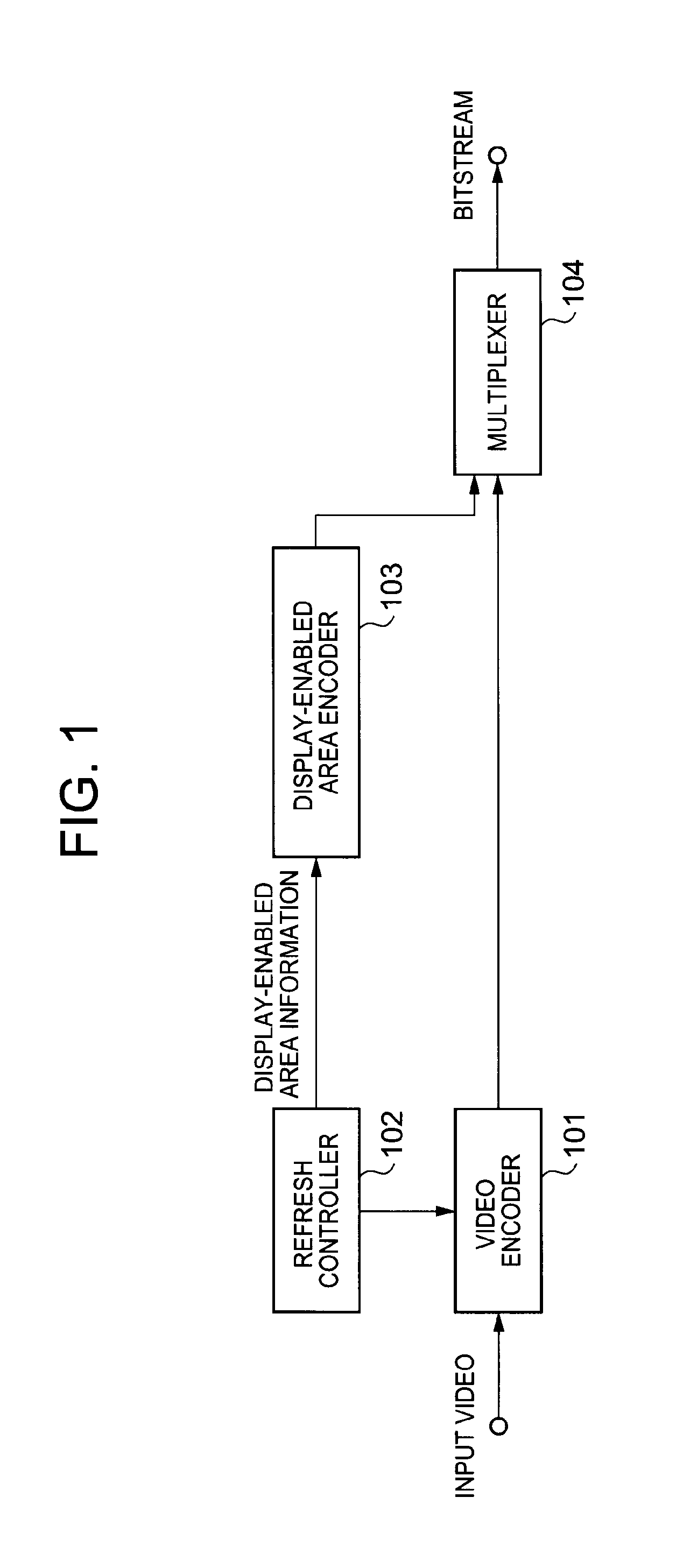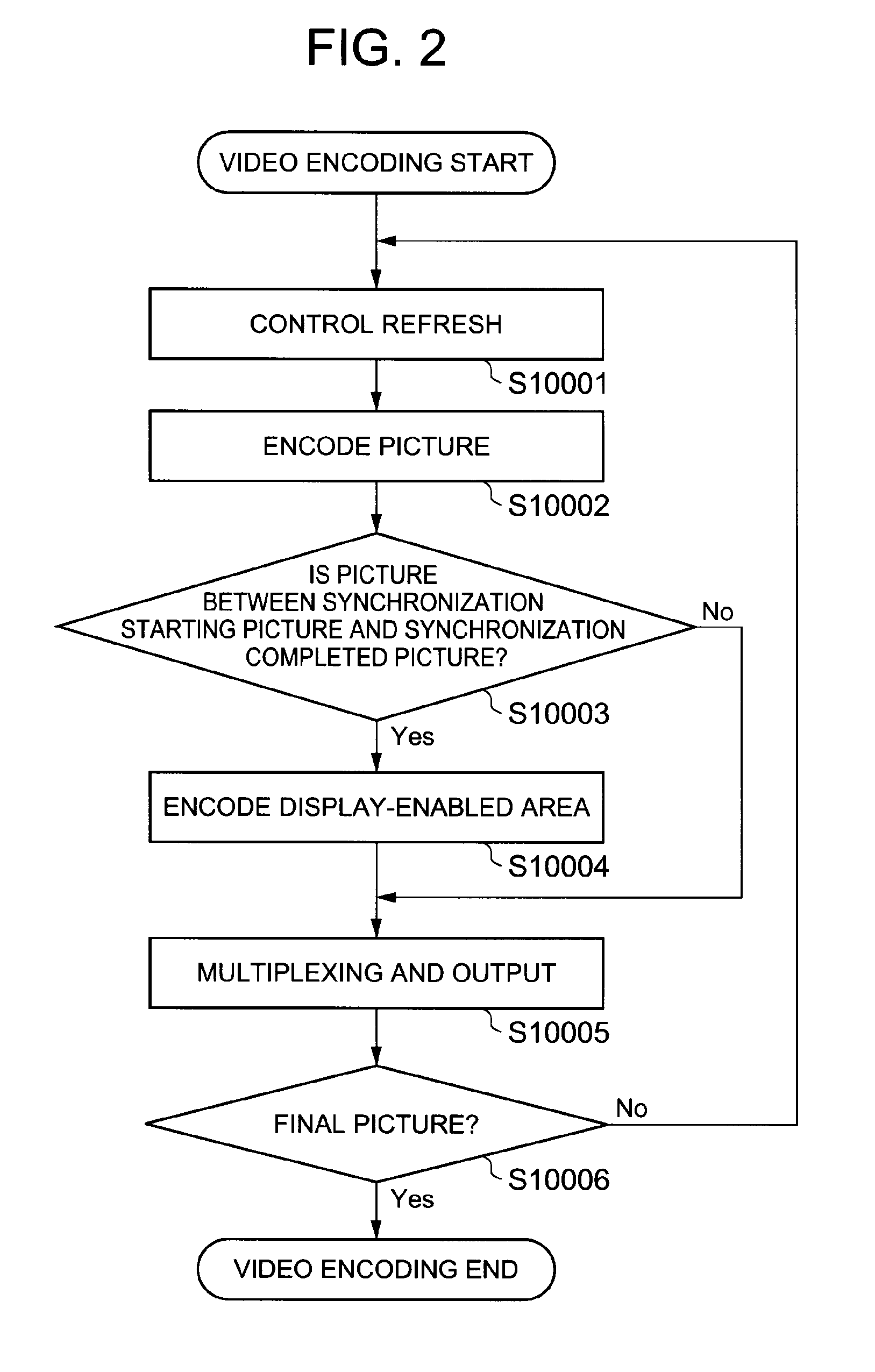Video encoding/decoding device, method, and program
a video encoding and decoding technology, applied in the field of video encoding/decoding devices, can solve the problems of difference in compression efficiency, increase transmission delay, and difference in prediction efficiency, and achieve the effect of reducing display delay
- Summary
- Abstract
- Description
- Claims
- Application Information
AI Technical Summary
Benefits of technology
Problems solved by technology
Method used
Image
Examples
first exemplary embodiment
[0058]FIG. 1 is a block diagram of a video encoding device according to a first exemplary embodiment of the present invention. As illustrated in the drawing, the video encoding device of the first exemplary embodiment includes a video encoder 101, a refresh controller 102, a display-enabled area encoder 103, and a multiplexer 104. The present exemplary embodiment is characterized in that the display-enabled area encoder 103 which encodes display-enabled area information of each picture obtained from the refresh controller 102 for supplying to the multiplexer 104.
[0059]The video encoder 101 performs encoding on each of pictures in an input video and supplies a bitstream of the video to the multiplexer 104.
[0060]When an adaptive predictive coding is performed in the video encoder 101, the refresh controller 102 supplies a control signal to the video encoder 101 such that prediction restriction is kept between refreshing groups of segments so as to perform intended refresh. The refresh...
example
[0071]A specific example of the video encoding device of the above first exemplary embodiment will be described below.
[0072]In the present example, with respect to a progressive video in which a spatial resolution for each frame is 320×240 pixels, the most left area of 64×240-pixel areas obtained by uniformly dividing a picture by 5 in a horizontal direction is set as an intra-coded segment, and refresh is performed so that an intra-coded segment is shifted so as not to be overlapped with each other through 5 pictures.
[0073]FIG. 3 illustrates a specific case where refresh is performed. In FIG. 3, a picture P (ti) at time ti is assumed as a synchronization starting picture, and P(ti+4) is assumed as a synchronization completed picture. A refresh completion segment in the picture P(t) at time t indicates an area set as an intra-coded segment one time from time ti to time t. In this case, respective display-enabled areas of pictures P (ti), P (ti+1), P (ti+2), P (ti+3) and P (ti+4) are...
second exemplary embodiment
[0105]FIG. 8 is a block diagram of a video decoding device according to a second exemplary embodiment of the present invention. As illustrated in FIG. 8, the video decoding device of the second exemplary embodiment includes a demultiplexer 201, a video decoder 202, a display-enabled area decoder 203, and a video output controller 204. The present exemplary embodiment is characterized in that the display-enabled area decoder 203 that decodes and outputs information of a display-enabled area in each picture is provided, and the video output controller 204 that interprets the display-enabled area and performs control such that a decoded image other than the display-enabled area is not output is also provided.
[0106]The demultiplexer 201 demultiplexes a bitstream, extracts a video bitstream and a display-enabled area information bitstream, and supplies the video bitstream to the video decoder 202, and supplies the display-enabled area information bitstream to the display-enabled area dec...
PUM
 Login to View More
Login to View More Abstract
Description
Claims
Application Information
 Login to View More
Login to View More - R&D
- Intellectual Property
- Life Sciences
- Materials
- Tech Scout
- Unparalleled Data Quality
- Higher Quality Content
- 60% Fewer Hallucinations
Browse by: Latest US Patents, China's latest patents, Technical Efficacy Thesaurus, Application Domain, Technology Topic, Popular Technical Reports.
© 2025 PatSnap. All rights reserved.Legal|Privacy policy|Modern Slavery Act Transparency Statement|Sitemap|About US| Contact US: help@patsnap.com



